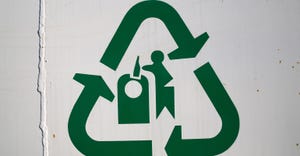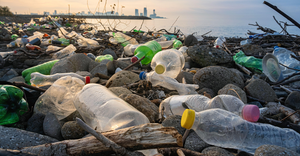Aseptic boxes, also known as drink boxes, were introduced into the United States in 1981 to house liquids, primarily beverages such as milk, fruit juices and wine.
Aseptic processing involves high-temperature treatment for a short time. Liquid products are heated quickly to the temperature at which sterilization occurs, then cooled and placed into a sterile container.
By weight, aseptic boxes are 70 percent paper (used for stiffness and strength), 24 percent polyethylene (used in four different layers to seal the package tightly) and 6 percent aluminum foil (used as a barrier against air and light). The boxes can protect beverages for a year or more without refrigeration.
Additionally, milk cartons, also known as gable top cartons, are the most common form of polycoated paper packaging. By weight, milk cartons are 80 percent paper and 20 percent polyethylene. Paper cartons for milk, however, have been rapidly losing market share to plastic containers. Other polycoated paper packaging such as frozen food boxes, round ice cream cartons and microwaveable dinner cartons are not included in this profile.
Aseptic Boxes, Milk Cartons MSW Facts:
Generated:
470,000 tons of milk cartons or 0.2% of municipal solid waste (MSW) by weight.*
60,000 tons of aseptic boxes or 0.03% of MSW by weight.
3.5 pounds of milk cartons per person per year.*
0.5 pounds of aseptic boxes per person per year.
17 drink boxes per person per year.
The average milk carton weighs 1 ounce.
The average aseptic box weighs 10 grams (approximately 90,000 drink boxes in one ton).
Recycled:
Milk cartons had a “negligible” recycling rate in 1998.*
EPA did not estimate a drink box recycling rate.*
The aseptic industry does not estimate a recycling rate. It claims, however, that 12 million Americans have access to either curbside or drop-off programs.
Recycled Content:
Possible, but not common with aseptic boxes or milk cartons.
Composted:
The mix of materials in both packages creates composting problems. Aluminum foil and polyethylene are noncompostable. Composting operations will attempt to remove both by mechanical means.
Incinerated or Landfilled:
470,000 tons of milk cartons or 0.3% of discarded MSW by weight.*
60,000 tons of aseptic boxes or 0.04% of discarded MSW by weight.*
High Btu values (19,000 Btus per pound for polyethylene and more than 7,000 Btus per pound for paper as compared to 4,500 Btus to 5,000 Btus for 1 pound of MSW).
The aluminum foil in the aseptic box will not combust and will end up as a residue in the ash.
Landfill Volume:
1.1 million cubic yards or 0.3% of landfill space in 1997 for milk cartons.
Aseptic box landfill volume is not estimated by EPA but would be negligible.
Density:
Landfilled milk boxes have density of 820 pounds per cubic yard.
Aseptic boxes and milk cartons collected at the curbside have a density of 80 pounds per cubic yard to 100 pounds per cubic yard.
Source Reduction:
Aseptic boxes are a source reduction marvel. They are lightweight, save on transportations costs and energy. Milk packaged in an aseptic box can last for a year without the need for refrigeration.
Although aseptic boxes are difficult to recycle, their source reduction advantages are more environmentally important.
Paper milk cartons replaced refillable glass bottles in the 1950s, offering a convenient, lightweight alternative for consumers. Today, milk cartons are being replaced by lighter weight plastic milk bottles.
Recycling Markets:
The long paper fibers found in aseptic boxes and milk cartons are valuable. However, because of handling problems caused by liquid residue in the packages, only three American paper mills use these products as a raw material. End-products from these mills include printing and writing paper, tissue, and paper towels.
The Recycling Process:
Aseptic boxes are hydropulped to separate paper fibers from plastic and aluminum foil. Because graphics are printed on the outer polyethylene layer, the paper fiber does not require deinking. The plastic can be burned for steam at a paper mill. If local markets exist, the plastic-foil mix can be used for plastic lumber.
Recycling Cost and Value:
Due to the limited number of programs, good cost data does not exist.
Chaz Miller is director of state programs for the Environmental Industry Associations, Washington, D.C. E-mail the author at: [email protected]. To view additional Profiles in Garbage, visit www.wasteage.com.
Sources:
Aseptic Packaging Council, Chicago. Website: www.aseptic.org
“Municipal Solid Waste Generation, Recycling and Disposal in the United States: Facts and Figures for 1998,” U.S. Environmental Protection Agency Office of Solid Waste, 2000. Website: www.epa.gov/osw
Paperboard Packaging Council, Alexandria, Va. Website: www.ppcnet.org
* 1998 U.S. EPA estimates.
About the Author(s)
You May Also Like




